
2nd Bn XX The Lancashire Fusiliers WW1. Ypres, 1915 |
Private John Lynn VC, DCM
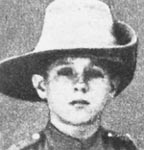 |
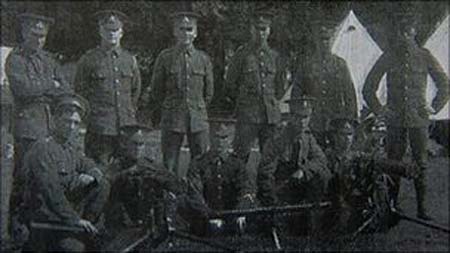 John Lynn 2nd from left front row this is two years before he won his VC on the right back row is Sgt Egar Parkinson who body was found in Belgium 2010 |
Click here and see the Pathe news film it show's John in action its quite a way into the film
It is a very big file and will take a while to download, so be patient.
Private John Lynn VC, DCM. Lancashire Fusiliers - The Forgotten Hero.
(A few years ago, by accident, I found
out about this remarkable Fusilier. The following is a brief
summary of what I've discovered about him.)
John Lynn, who won the VC at Ypres, May
1915, was born in Forrest Hill, South London in 1888 and spent
his early years in the area. However the only memorial to
John, in England, appears to be the one at the church of St
Mary the Virgin, Bury, Greater Manchester.
Unfortunately information on John is sparse.
His army service records do not appear to have survived. (I
cannot find trace of them amongst the 'Unburnt Documents'
held at the PRO, Kew.) The information that is readily available
tends to concentrate on the events leading to his winning
the DCM and the VC while serving with the 2nd Battalion the
Lancashire Fusiliers during WW1.
Winning the VC.
An extract from the "London Gazette,"
dated 29th June 1915, records the following: -"For most
conspicuous bravery near Ypres on 2nd May 1915. When the Germans
were advancing behind their wave of asphyxiating gas, Pte.
Lynn, although almost overcome by the deadly fumes, handled
his machine gun with very great effect against the enemy,
and when he could not see them he moved his gun higher up
on the parapet, which enabled him to bring even more effective
fire to bear, and eventually checked any further advance.
The great courage displayed by this soldier had a fine effect
on his comrades in the very trying circumstances. He died
from the effects of gas poisoning."
As a result of this action John also had the rare distinction of being named in Sir John French's dispatches.
On December of the previous year, John
was also awarded the DCM for his courage when he to quote
from the Gazette of the 17th December 1914, ' For gallant
conduct. Took charge of an isolated machine gun when his Serjeant
was killed, brought it out of action when jammed and took
it back again to the firing line when repaired.'
John was also awarded posthumously, on the 25th August 1915, the Cross of St George 4th Class (Russia).
John died the day after the action, which
gained him the VC. He was buried in Vlamertinghe Churchyard,
Belgium but his grave was later destroyed by shellfire and
there is now a special memorial stone erected to him at the
Grootebeek British Cemetery.
John's name is also listed on the WW1 memorial
in St Mary's Church, Bury, Lancs. This appears to be the only
memorial to him in England.
His Family.
Although John's gallant actions are well
recorded, as noted earlier, knowledge about John, his parents
and foster parents is sparse. The following is a summary of
what is known.
A recently discovered birth certificate
shows John was born on the 21st April 1888 at 6 Helvetia St,
Perry Hill, Catford. London. (This differs from other records,
which give a birth year of 1987.) His mother was a Lily Lynn
and his father was unknown.
An Elizabeth Harrison, of the same address, registered John's birth under the name John Walter Harrison Lynn.
Elizabeth and her husband, Phillip, apparently
acted as John's foster parents throughout his childhood. What
is known suggests that John may have had a difficult childhood.
He attended Christ Church School, Forest
Hill, London, SE23 and his family home was variously 20 Hindsley
Place or 2 Church Vale, Forest Hill. His foster mother was
a laundress/ washerwoman.
For some unknown reason in1899, possibly as a result of the death of his foster father, John came under the care of the Lewisham Board of Governors. On the 1/9/1899, he was sent to the North Surrey District School, Anerly, Upper Norwood, Surrey. The school records show he ran away from the school once during the short period he was there.
On the18/10/1899 he was moved to the TS
Exmouth, a training ship, which was moored on the Thames at
Grays, Essex. The records show that his behaviour generally
was very good and towards the end of his stay on board the
Exmouth was rated First Class on the Clarinet but only Second
Class in Seamanship and Swimming.
On the 12/01/1901 John, with Elizabeth
Harrison's approval, joined the 3rd Battalion, Lancashire
Fusiliers as a band boy. He joined under the name of John
Lynn and also appears to have been registered as Irish.
John served in the army until 1912/13;
prior to his discharge he was stationed in Bury and met and
became engaged to Alice Mason. On his discharge he began living
in Gorton, Manchester with the family of his fiancée,
Alice Mason, while working at Armstrong-Whitworth Ltd.
John and Alice were due to be married in
November 1914 but unfortunately John, as a reservist, was
recalled to the 2nd Battalion of the Lancashire Fusiliers
at the outbreak of war. Alice was on holiday and they did
not get a chance to say goodbye before John went with the
Battalion. John and Alice's rearranged plans for marriage
unfortunately were overtaken by his death.
In March 1916 the War Dept. sent his medals to Alice, as his legatee. In 1955, Alice presented the medals to the Lancashire Fusiliers Museum in Bury where they are now held.
The Questions.
So who was John Lynn? We know he was a
hero, but who was he? Was he a good soldier?
There are a lot more unanswered questions:
" Who was Lily Lynn, his mother? Who was his Father? " Who were the Harrison's, his foster parents? " Did he have any foster brothers and sisters? " Are there families living today who could claim a direct link to John? " Was he Irish? The only information, which supports this claim, comes from a web-site www.firstfusiliers.com. Was this a clerical error at recruitment or later, or did it link back to his real mother or Father. (The Web-site no longer appears to be supported but was linked to the Lancashire Fusiliers Museum site.) The Commonwealth War Graves Commission list him as an English Soldier. " Are there descendants of the Mason family still alive in the Manchester area, who might know something about Alice? She had 3 sisters and 2 brothers. Alice, who was born in Gorton Manchester in 1887, does not appear to have married, but it is known that a grand nephew, Alan Murdey lives in Essex.
If you can add anything to this story of
John Lynn, please e-mail the Editor of this web-site or myself.
John Harrington-Lynn.
(johnl.vc@hotmail.co.uk) |
From the Field-Marshal Commanding-in-Chief,
The British Army in the Field.
To the Secretary of State-for-War, War Office, London, S.W.
To the Secretary of State-for-War, War Office, London, S.W.
General Headquarters,
15th June, 1915.
15th June, 1915.
The eighth Despatch of Field Marshal
Sir John French, Commander in Chief of the British Expeditionary
Force. Printed in the Second Supplement to the London
Gazette of 10 July 1915. The Despatch dealt with the
intensive fighting at Hill 60 and in the Second Battle
of Ypres, and with the less than wholly successful attacks
of Aubers Ridge and Festubert. French is fulsome in
his praise of Plumer: he does not mention that Plumer
arrived to take the place of Smith-Dorrien, who French
had sacked.
( http://www.1914-1918.net./frenchs_eighth_despatch.htm } |
My Lord,-
I have the honour to report that since the date of my last) despatch (5th April, 1915) the Army in France under my command has been heavily engaged opposite both flanks of the line held by the British Forces. ……….
There have been many cases of individual gallantry. As instances may be given the following: -
During one of the heavy attacks made against our infantry gas was seen rolling forward from the enemy's trenches. Private Lynn of the 2nd Lancashire Fusiliers at once rushed to the machine gun without waiting to adjust his respirator. Single-handed he kept his gun in action the whole time the gas was rolling over, actually hoisting it on the parapet to get a better field of fire. Although nearly suffocated by the gas, he poured a stream of lead into the advancing enemy and checked their attack. He was carried to his dug-out, but, hearing another attack was imminent, he tried to get back to his gun. Twenty-four hours later he died in great agony from the effects of the gas.
http://www.lancs-fusiliers.co.uk/gallerynew/2LFWW1/2lfww1Ypres.htm
I have the honour to report that since the date of my last) despatch (5th April, 1915) the Army in France under my command has been heavily engaged opposite both flanks of the line held by the British Forces. ……….
There have been many cases of individual gallantry. As instances may be given the following: -
During one of the heavy attacks made against our infantry gas was seen rolling forward from the enemy's trenches. Private Lynn of the 2nd Lancashire Fusiliers at once rushed to the machine gun without waiting to adjust his respirator. Single-handed he kept his gun in action the whole time the gas was rolling over, actually hoisting it on the parapet to get a better field of fire. Although nearly suffocated by the gas, he poured a stream of lead into the advancing enemy and checked their attack. He was carried to his dug-out, but, hearing another attack was imminent, he tried to get back to his gun. Twenty-four hours later he died in great agony from the effects of the gas.
http://www.lancs-fusiliers.co.uk/gallerynew/2LFWW1/2lfww1Ypres.htm
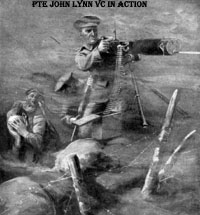
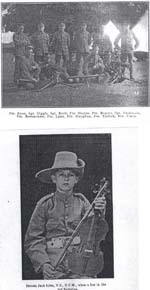
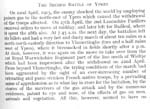
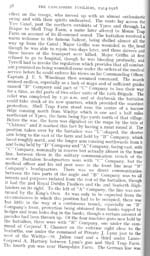
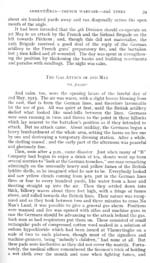
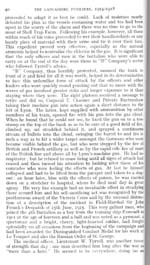
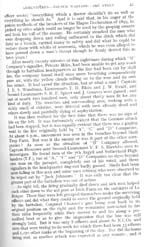
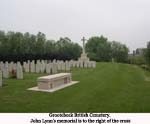
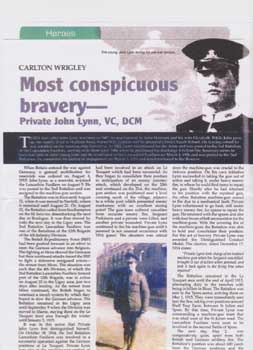
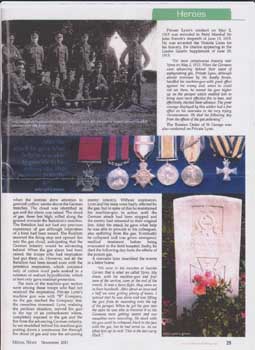



No comments:
Post a Comment